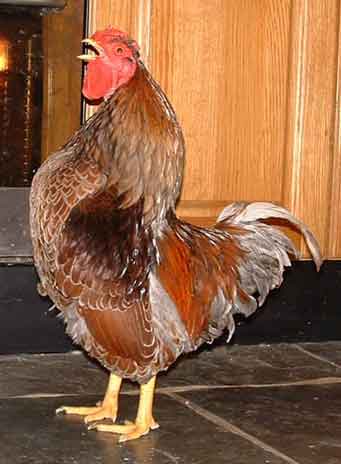Northern Fowl Mite, although not well known, is the most dangerous parasite of poultry. This mite reproduces fast and being a bloodsucker, if not treated quickly, is
 lethal.
lethal.There has been a plague of northern fowl mite this year – probably something to do with summers lacking scorching heat and being damp. The recent cold spell will have done nothing to inhibit it, as it is a creature of colder climates and living on the bird all the time is nicely insulated from the weather by a thick feathery duvet.
As chickens catch it from wild birds it is almost impossible to avoid contact with it at some stage. There have been fatalities in the area so it is worth being extra vigilant with your own birds.
Symptoms
Northern mite when you actually see it is absolutely disgusting but it’s hard to spot especially in the early stages. Not all birds in the same flock will be affected; so all birds need careful checking. Birds with a heavy infestation become miserable, weak and are unusually thirsty. The Infested area, usually their backend, at first glace just looks dirty, almost greasy. Closer investigation shows the dirt to be at the base of the feathers and in a good light, if you have good eyesight, you can see the dirt is moving. Hundreds of tiny pinprick sized grey-red bodies seethe amongst the feathers trying to get out of the light and will even swarm up your arms. As the mites get older they grow to the size of a pinhead and are slate grey.
Treatment
Once the little beasties are established they are fairly resistant to dying. The whole bird needs to be treated even if the infestation is localised round the vent as any that escape will gather their strength for a new attack, a couple of weeks later on a different part of the bird.
The irritation the mites cause makes the bird’s skin lift and go crusty making treatment harder. Most treatments for use on birds against mites and lice do work, you just need to be a bit heavy handed with them. Pyrethrum sprays and powders sold for cats and dogs also work, so does the pyrethrum louse powder sold to treat animal bedding and horse rugs but it isn’t licensed for “on animal treatment”. Organic Barrier liquid works if made up at a much greater concentration than it says on the bottle, about 1:20 or stronger is successful. Surgical spirit, dropped onto the skin, seems to work too. Vets may recommend other sprays.
Any birds that have had a heavy infestation will need a bit of extra care for a week or two until their strength has built back up. This means keeping them warm, supplementary feed such as egg, cat food (also unlicensed for chickens), vitamins and minerals.
Prevention
Some of the organic treatments including Barrier mite powder will help to deter mite.
There are various “pour-on” treatments for cattle, Ivomectin was one, Eprinex is another; they can are used to cure worms and prevent a wide range of external parasites. They have been used successfully on poultry for some time however they are not licensed for use on birds. I have found that Eprinex prevents lice and red mite and it seems to be effective against Northern mite too.
 A blue laced Wyandotte cockerel who has just about recovered from a bad infestation of Northern Fowl mite.
A blue laced Wyandotte cockerel who has just about recovered from a bad infestation of Northern Fowl mite. The trouble arose a fortnight after I first noticed and treated mites around his backend. All the other birds he lived with were completely clear after the first treatment and I assumed he was too. However he started to drink more than usual, didn’t look his usual chirpy self and was getting picked on by the other cockerels.
It is harder to notice problems on cockerels than hens because they don’t let on they have anything wrong until it has become very bad indeed. When I picked him up I found that he was thickly and greasily infested with microscopically small mites on his breast, neck, legs and wings – everywhere other than where I’d first treated him – and terribly weak.
I sprayed him with Johnson’s pigeon spray, but there were so many mites and his skin was so encrusted they wouldn’t die. Weak as he was, the decisions was made to bath him in medicated dog shampoo. It took three washes to clean the mites and their filthy residue out of his feathers. He was then sprayed again. The ordeal of a bath on top of his mite problems nearly killed him and he was so weak he could hardly stand.
For three days he drooped and looked like he was going to die. He was kept in a warm room with a heat lamp over him. He wouldn’t eat but was still very thirsty so he was given live bio-yoghurt (yoghurt seems to have a magical effect on chickens for all manner of problems) to drink as it provides nutrition as well as liquid. He was then tempted with raw egg (which is almost irresistible to chickens), thicker yoghurt, cat food and porridge oats. On day five he crowed. On day six he dust bathed under his heat lamp. He still isn’t ready to put up with the incredibly cold recent weather so is still indoors recuperating.
Clare Skelton 20th February 2003